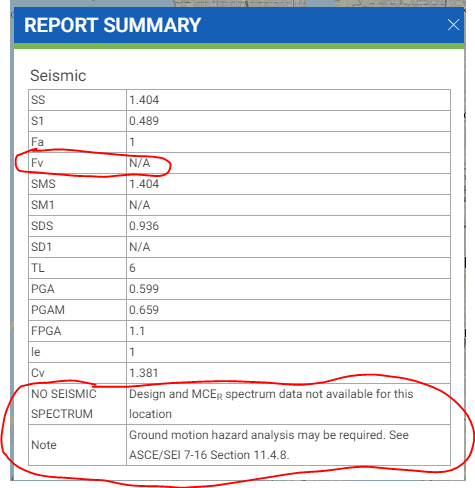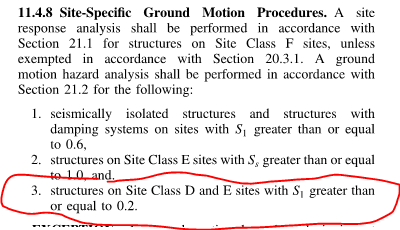sticksandtriangles
Structural
I am interested in how people out west address these high seismic regions...
I am trying to do equivalent lateral force procedure on a building out in Seattle Washington (outside of my typical area of the midwest)...
My typical procedure to do this is to go to the USGS/ASCE Hazard tool and get my seismic design parameters.
After running the report I get the following:

To my surprise Sd1 is not output, only an N/A.
Digging into this, it kicks you to ASCE 7-16 section 11.4.8.
Based on my data i think I need to do the following:
[ul]
[li]Based on item (3) of 11.4.8:

we are required to perform a ground motion hazard analysis in accordance with section 21.2.[/li]
[/ul]
[ul]
[li]Ok so onto 21.2 assuming none of the exceptions apply to me. Based on how I read 21.2, i need to create a probabilistic ground motion response per 21.2.1 and a deterministic ground motion response per 21.2.2.
Is there a website that produces both the probabilistic ground motion response per 21.2.1 and a deterministic ground motion response per 21.2.2?
[/li]
[/ul]
[ul]
[li]From here, it looks like a seismic response spectrum curve is spit out and I can multiply by 2/3*Fv per 21.3-1 and achieve Sd1?
 [/li]
[/li]
[/ul]
After all of this, I can then determine the seismic design category based off of Sds and Sd1?
If all of the above is the correct interpretation of the code, the only thing I need guidance on is how to obtain the probabilistic ground motion response per 21.2.1 and a deterministic ground motion response per 21.2.2.
Thanks again in advance for your help!
S&T
I am trying to do equivalent lateral force procedure on a building out in Seattle Washington (outside of my typical area of the midwest)...
My typical procedure to do this is to go to the USGS/ASCE Hazard tool and get my seismic design parameters.
After running the report I get the following:

To my surprise Sd1 is not output, only an N/A.
Digging into this, it kicks you to ASCE 7-16 section 11.4.8.
Based on my data i think I need to do the following:
[ul]
[li]Based on item (3) of 11.4.8:

we are required to perform a ground motion hazard analysis in accordance with section 21.2.[/li]
[/ul]
[ul]
[li]Ok so onto 21.2 assuming none of the exceptions apply to me. Based on how I read 21.2, i need to create a probabilistic ground motion response per 21.2.1 and a deterministic ground motion response per 21.2.2.
Is there a website that produces both the probabilistic ground motion response per 21.2.1 and a deterministic ground motion response per 21.2.2?
[/li]
[/ul]
[ul]
[li]From here, it looks like a seismic response spectrum curve is spit out and I can multiply by 2/3*Fv per 21.3-1 and achieve Sd1?

[/ul]
After all of this, I can then determine the seismic design category based off of Sds and Sd1?
If all of the above is the correct interpretation of the code, the only thing I need guidance on is how to obtain the probabilistic ground motion response per 21.2.1 and a deterministic ground motion response per 21.2.2.
Thanks again in advance for your help!
S&T

![[bigsmile] [bigsmile] [bigsmile]](/data/assets/smilies/bigsmile.gif)